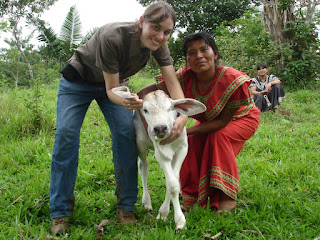 |
| Thanksgiving dinner |
With a Thanksgiving theme, some of the things I'm thankful for are:
- The cell phones and the internet that connect me with loved ones and friends far away and nearby.
- A group of other volunteers to share this experience with.
- A community that's friendly and excited about working with me.
- The generosity of that community, even when it seems they have so little.
- The beautiful natural world that I live and work in.
- My own access to financial resources and opportunity, which is far beyond that of my community here (this disparity is not something to be thankful for, of course, but I am thankful for what I do have.)
- The presence of churches in my area, including one that I think I'd like to continue attending (after visiting most of them).
- I pray that God would increase my understanding of the Gospel, that I would be more thankful to Him for all he's given me, and for the way he's redeemed this life.
- Finally, I'm thankful that my community has good access to a road and government-run medical facilities:
A little girl in my community is sick with severe pneumonia, and is in the hospital with a tube in her side. It's a good thing she's in the hospital and receiving, we hope, the best of medical care. It's too bad the family didn't take her earlier, but they thought, as did I, that it was a severe chest cold. While I'm working in health, I'm not trained in medical care and it's humbling.
On a different topic entirely, the economy works in really interesting ways here. People are connected to each other and the outside world in many complex ways. It's going to take a long time for me to understand more fully what's going on, but here are some of the ways my family gets by:
In- the current season's agricultural crops
Rice, Yucca, Coffee, Cacao, Otoi (root vegetable), Squash, Bananas, Plantains, Chickens
In- money
Govt welfare (dependent on the kids' enrollment in school and the health center)
Selling coffee, cacao, and chickens informally to neighbors
Work for pay on others' farms (a few days here and there)
Sewing dresses (on a hand cranked machine)- something many women in the community do
In- Sharing
The grandmother, who works in a distant town as domestic help, sent plantains and smoked beef one day.
Outlays- I have a very incomplete picture here.
Food
Supplies such as soap, matches, string
School supplies, uniforms
Clothing
Travel
Sharing food with other families
Expenses related to medical care (the care itself is subsidized)
People in my community also practice several handicrafts:
Some women in the community make "chackras," net bags. They start by twisting cordage, either out of unravelled plastic rope, or natural fibers (which is a whole process of preparation unto itself). Then the bags are crocheted, either by hand or using a crochet hook, depending on the size. It's very labor intensive. Bags are used for firewood, babies, bananas, purses, and cell phones, in descending order of size.
This is a giant bag for firewood! Or maybe just for show... imagine an old lady twisting this cordage on her thigh, to make the rope that this bag is made out of! Dyed with natural "tintas."
A handful of men in the larger community make sombreros, also out of natural fibers. This is traditionally men's work, while the chackras are women's work.
To make the distinctive dresses, "nagwas", ladies generally use hand crank or foot pedal operated sewing machines. Quite a few of them have a side business of sewing clothes to order for other families. I really like the dresses and I ordered one for myself, which turned out really nicely... I hope to have a few. I hope to take a picture soon of me wearing it.






















